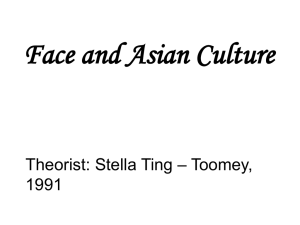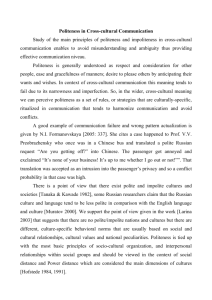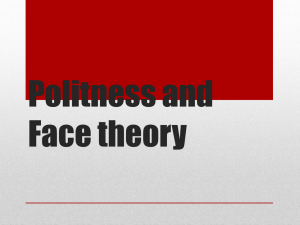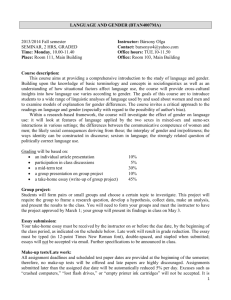Testing Brown and Levinson's theory in a corpus of spontaneous
advertisement
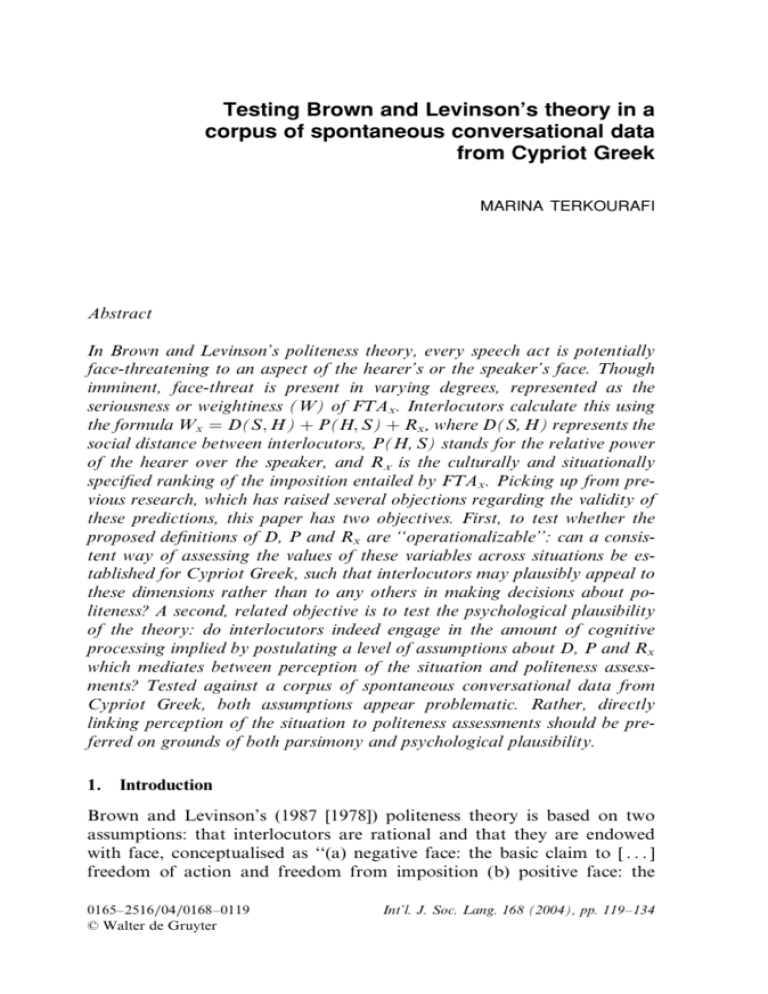
Testing Brown and Levinson’s theory in a
corpus of spontaneous conversational data
from Cypriot Greek
MARINA TERKOURAFI
Abstract
In Brown and Levinson’s politeness theory, every speech act is potentially
face-threatening to an aspect of the hearer’s or the speaker’s face. Though
imminent, face-threat is present in varying degrees, represented as the
seriousness or weightiness (W) of FTAx . Interlocutors calculate this using
the formula Wx ¼ D(S; H) þ P(H; S) þ Rx , where D(S, H) represents the
social distance between interlocutors, P(H, S) stands for the relative power
of the hearer over the speaker, and Rx is the culturally and situationally
specified ranking of the imposition entailed by FTAx . Picking up from previous research, which has raised several objections regarding the validity of
these predictions, this paper has two objectives. First, to test whether the
proposed definitions of D, P and Rx are ‘‘operationalizable’’: can a consistent way of assessing the values of these variables across situations be established for Cypriot Greek, such that interlocutors may plausibly appeal to
these dimensions rather than to any others in making decisions about politeness? A second, related objective is to test the psychological plausibility
of the theory: do interlocutors indeed engage in the amount of cognitive
processing implied by postulating a level of assumptions about D, P and Rx
which mediates between perception of the situation and politeness assessments? Tested against a corpus of spontaneous conversational data from
Cypriot Greek, both assumptions appear problematic. Rather, directly
linking perception of the situation to politeness assessments should be preferred on grounds of both parsimony and psychological plausibility.
1. Introduction
Brown and Levinson’s (1987 [1978]) politeness theory is based on two
assumptions: that interlocutors are rational and that they are endowed
with face, conceptualised as ‘‘(a) negative face: the basic claim to [ . . . ]
freedom of action and freedom from imposition (b) positive face: the
0165–2516/04/0168–0119
6 Walter de Gruyter
Int’l. J. Soc. Lang. 168 (2004), pp. 119–134
120
M. Terkourafi
Lesser
Elimination
on record
1. without redressive
action, baldly
4. off record
with redressive
action
Do the FTA
of risk
of face loss
2. positive politeness
3. negative politeness
5. Don’t do the FTA
Greater
Figure 1.
Strategies for performing FTAs (Brown and Levinson 1987 [1978]: 60)
positive consistent self-image or ‘personality’ claimed by interactants’’
(Brown and Levinson 1987 [1978]: 61). The face-threatening potential of
an act (FTA) is represented as its weightiness (W). To calculate this, the
social Distance between interlocutors, the Power of the addressee over
the speaker, and the Ranking of an imposition are compounded using
the formula Wx ¼ DðS; HÞ þ PðH; SÞ þ Rx (Brown and Levinson 1987
[1978]: 76–77). D, P and Rx are assessed anew for each FTAx . Moreover,
once combined in the Wx value of an FTAx , the particular values of D, P
and Rx become untraceable, ‘‘mak[ing] the sources of the final assessment
[of Wx ] ambiguous’’ (Brown and Levinson 1987 [1978]: 81). As the
weightiness of an FTAx increases, interlocutors move upwards along a
scale of increasing indirectness represented as a hierarchy of strategies
(Figure 1). While these strategies and their ordering are claimed to be
universal, the weightiness of a particular FTA, based on the values of D,
P and R calculated for this act, will be culture-specific.
Brown and Levinson proposed these variables inspired, at least in part,
by Brown and Gilman’s (1960) analysis of T/V address systems. Challenging the homogeneity of the latter’s findings, Braun draws attention to
their restricted selection of informants (upper–middle-class males from
urban areas), and to the ‘‘long and successful process of standardisation’’
(Braun 1988: 24) undergone by the languages analyzed. In this respect,
Cypriot Greek with its nonstandard character, as well as the inclusion
of speakers from both sexes and various socioeconomic backgrounds in
the present study, provide an ideal ground for testing the universality of
Brown and Levinson’s predictions. As a first approximation, our findings
do justice to Braun’s claims: the proposed definitions of D, P and R, as
well as the formula combining their values in one numerical estimate of
the weightiness of an FTAx, fail to account for politeness realizations in
the Cypriot Greek data. Instead, allowing extralinguistic features of the
Testing Brown and Levinson’s theory in Cypriot Greek
121
situation to enter directly into interlocutors’ assessments of politeness
yields the correct predictions.
Previous research has raised several objections regarding the validity of
Brown and Levinson’s predictions. The monodirectional impact of D on
degree of indirectness has been challenged by findings that similar patterns may be observed between intimates and strangers, while more e¤ort
is invested with acquaintances (Wolfson 1989). The assumed independence of D and P is similarly not empirically supported (Holtgraves and
Yang 1990: 725; Watts et al. 1992: 9; Tannen and Kakava 1992: 13).
Furthermore, factors determining politeness assessments may not reduce
without residue to values of D, P and R. Familiarity and a¤ect (Slugoski
and Turnbull 1988), the interlocutors’ sex (Holmes 1988; Ide 1982), the
presence of third parties (Scollon and Scollon 1995: 34; Clark 1996: 15)
and the extent to which the situation calling for face-work is standard
(Vollmer and Olshtain 1989) have been shown to interact with the proposed variables in determining the choice of strategy.
This article tests whether D, P and Rx as currently defined account for
the distribution of politeness strategies in a corpus of spontaneous conversational Cypriot Greek data. Not only does it emerge that D, P and
Rx must be construed di¤erently on di¤erent occasions if the proposed
association of degree of indirectness with the sum of D, P and Rx is to be
upheld, it also turns out that appealing to perceptually assessed extralinguistic features instead yields more accurate predictions as to the politeness strategy selected. Such direct association between extralinguistic
features of the situation and politeness strategy selected militates against
postulating a level of assumptions about D, P and Rx , which is intermediate between perception of the situation and choice of strategy, and to
which extralinguistic features merely serve as input. If politeness indeed
‘‘most often passes unnoticed’’ (Kasper 1990: 193), that is, is somehow
unmarked, then a theory which implies less rather than more cognitive
e¤ort for interlocutors, by, for example, linking extralinguistic features of
the situation directly with politeness assessments, should be preferred.
2. Data collection and analysis
This study is based on spontaneous exchanges between adult native
Greek Cypriot speakers recorded in the four major urban centers of the
island and in a variety of settings. Using as a criterion whether the act
o¤ered or requested was desirable to the speaker or to the addressee
(Sperber and Wilson 1995 [1986]: 250–251), utterance-sequences realizing
o¤ers or requests were identified and transcribed.1 2,189 realizations of
122
M. Terkourafi
o¤ers and requests were subsequently analyzed for a number of variables,
linguistic and extralinguistic.
Among the linguistic devices available in Modern Greek for performing o¤ers and requests (Sifianou 1992), the present analysis considers: the
presence/absence of a main-clause verb predicating an act A of the
speaker or of the addressee, the type of main-clause verb, the subjective
modality expressed by it, the combination of numberþperson for which it
is marked, and additional markers of politeness (address terms, diminutives etc.).2 While each of these is, in principle, relatable to one or more
strategy (Brown and Levinson 1987 [1978]: 91–227; Figure 1), such a
move relies on the assumption that combinations of these devices are
somehow equivalent and can be used interchangeably. Aiming precisely
to test this assumption, this study refrains from taking this step.
To test the authors’ claim that the degree of indirectness of an utterance realising an FTAx is commensurate with the sum of the values that
the speaker assigns to D, P and Rx , a consistent way of assessing these
values, that is, one which is not (wholly) idiosyncratic, is required. Abandoning this requirement not only renders the theory unfalsifiable but also
makes it hard to explain how interlocutors may agree on their assessment
of the FTA-specific values of D, P and Rx (hence perceive each other to
be polite), if not wholly by coincidence. This article relies on the fundamental assumption that the situation-specific values of D, P and Rx may
be assessed drawing on extralinguistic features of the situation such as the
interlocutors’ sex, age, and social class, the relationship between them, the
setting of the exchange and whether the speech act performed occurs for
the first time or is repeated.
3.
3.1.
Main findings
The combined e¤ect of the three sociological variables on degree of
indirectness
If we estimate the values of D, P and Rx on particular occasions of use,
we find that the degree of indirectness of the utterances involved does not
increase analogously to the values of these variables. The most straightforward hypothesis in this respect is that requests and o¤ers exchanged
between speakers of the same sex, age and social class (low D) who occupy similar positions in the professional hierarchy (low P) should be
more direct than those exchanged between speakers of di¤erent ages and
sexes (high D, withholding assumptions about the power relations between di¤erent age-groups and sexes) occupying di¤erent positions in the
professional hierarchy (high P). In requests performed for the first time by
Testing Brown and Levinson’s theory in Cypriot Greek
123
middle-class men, aged 31 to 50, addressing middle-class men, aged 31 to
50, who are long-standing colleagues at work (low DþP), directness, in
the guise of AV-imperative-2sg., is preferred (24 out of 56 utterances, i.e.,
42.85%).3 This preference persists in requests performed for the first time
by middle-class women, aged 18–30, addressing middle-class men, aged
31 to 50, who are their employers at work, a situation of high D and high
P (3/8 utterances, i.e., 37.5%).
O¤ers show a similar picture. When o¤ering a thing/action for the first
time, middle-class men, aged 31 to 50, addressing middle-class men, aged
31 to 50, who are long-standing colleagues at work, prefer yélo, ‘to want’indicative with rising intonation-2sg. (4/20 utterances, i.e., 20%), and so
do middle-class women, aged 18 to 30, addressing middle-class men, aged
31 to 50, who are their employers at work (3/5 utterances, i.e., 60%).
In both o¤ers and requests, that is, speakers’ preferences regarding the
degree of indirectness of the main-clause verb of their utterances remain
una¤ected by di¤erent combinations of the values of the extralinguistic
variables, which, according to the definitions of D and P, should prompt
an increase in the context-specific values of these variables.
A similar degree of indirectness is also opted for as regards additional
markers of politeness. These include: (a) diminution (derivational via suffixation, or periphrastic); (b) embedded conditional clauses questioning
the addressee’s desires; (c) embedded clauses or prepositional phrases expressing purpose or reason. 20 out of 76 utterances (26.31%) exchanged
between middle-class men, aged 31 to 50, who are old colleagues at work
(low DþP), and 3 out of 14 utterances (21.42%) by middle-class women,
aged 18 to 30, to middle-class men, aged 31 to 50, who are their employers at work (high DþP), make use of one of these mitigation mechanisms.
The proximity of these ratios suggests that, contrary to prediction, an increase in the values of DþP is not accompanied by an increase in the
overall degree of indirectness of the observed utterances. What is more,
there is no qualitative di¤erence in the mitigating mechanisms preferred:
giving reasons for one’s utterance (possibility [c]) prevails in situations of
both low and high DþP.4
In the above instances, interlocutors exchange a greater number of requests and o¤ers when D and P are low (76 between 21 pairs; average
3.62/pair) than when they are high (14 between 6 pairs; average 2.34/
pair). This finding may be explained by appealing to Brown and Levinson’s fifth super-strategy, ‘Don’t do the FTA’. While increased D and P
values may well result in nonrealization of the FTA, this cannot be empirically verified. In addition, one would then have to explain why an increase in the values of D and P causes a polarization of speakers’ choices
around the two extremes of the proposed hierarchy of strategies (Figure
124
M. Terkourafi
1), rather than a shift toward higher-numbered strategies. Drawing on the
notion of Conversational Contract (Fraser and Nolen 1981; Fraser 1990),
I would propose instead that it is part of the terms of the conversational
contract (the negotiated rights and obligations of interlocutors) that employees conform to the wishes of their employers rather than express their
own. No such restriction applies between equals on the professional hierarchy. Thus, both the lesser number of o¤ers and requests addressed by
employees to employers and their direct performance are accounted for:
o¤ers and requests falling within the terms of the conversational contract
have been prenegotiated, so to speak, requiring no further explicit negotiation each time.
3.2.
Metaphorical Power?
The mostly asymmetrical distribution of FN þmu ‘my’ and titleþFN in
the data calls for explanation under the variable of Power. FNþmu is
used asymmetrically by 24 out of 30 pairs of interlocutors: typically older
women addressing younger addressees; recipients reply with FN or a
kinship term, such as mám:a ‘mum’. As a common address term used by
mothers to children, FNþmu could then be associated with the addressee’s low P over the speaker, explaining why a male employer can use
it to address a female employee:
(1)
lipón cı́takse, káne tilefónima esı́ marúla mu
‘OK look, you make the call, Marula dear.’
However, more than half of the instances of asymmetrical FNþmu usage
occur between friends, acquaintances, or old colleagues. To account for
these in terms of P, this must now be construed metaphorically. Power
based on age no longer emanates from (material or metaphysical) control
over one’s interlocutor and cannot be captured under its current definition (Brown and Levinson 1987 [1978]: 77). Instances when the addressee’s ‘‘real’’ (as opposed to metaphorical) power over the speaker is
not low, yet FNþmu is used, make this point rather dramatically.
(2)
eán éCis opjodı́pote endiazmó yélo, e ján:a mu?
‘If you have any questions, Yana dear?’
The addressee in example (2) is a customer entering the shop for the first
time. The salesperson’s repeated o¤ers (of services and advice) indicate
her desire to see the client return. The addressee, then, has at least some
power over the speaker. But by using FNþmu asymmetrically, the speaker
is instead asserting power over the addressee. This time, P does not emanate from the speaker’s relationship to the addressee; in fact, it runs contrary to it. The speaker can claim power over the addressee only meta-
Testing Brown and Levinson’s theory in Cypriot Greek
125
phorically: by behaving the way a mother would toward a child, she
conveys her desire to treat the addressee well.
TitleþFN is used asymmetrically by 12 out of 24 pairs of interlocutors.
This usage consists of one party giving titleþFN and receiving, variably,
FN, LN (without title, a usage nowadays confined to the army and the
classroom) or mána mu, literally ‘my mother’, an endearing form of address. Older age in a work setting turns out to be the guiding principle in
asymmetrical titleþFN usage.5 However, age can only metaphorically be
construed as a source of P. Power based (solely) on age is, so to speak,
‘‘nominal’’: it cannot be enforced in the direct way that Brown and Levinson’s definition implies.
By extension, titleþFN comes to encode appreciation/respect: enhancing his/her own positive face by appearing to be a competent member of society is the speaker’s primary concern in this case. Expressing
appreciation/respect can, then, override considerations of social class
or relationship, even when these would normally tip the balance of power
in favor of the speaker.6 This is clear in example (3), where a younger
working-class female salesperson receives titleþFN by an older, middleclass long-standing customer.
(3)
éla cirı́a (.) éla cirı́a eléni. distixós éna
‘Come Mrs (.) come Mrs Eleni. Unfortunately {only} one {juice}’
A metaphorical construal of P leaves us with a notion that is hardly
constrained: it can be in conflict with concrete sources of power and may
even override them (as in examples [2] and [3]).7 How is a speaker to decide which to attend to, real or metaphorical P, if we extend its definition
in this way? Rather, asymmetrical FNþmu and titleþFN usage appear to
be directly tied to extralinguistic features of the situation.8 Strategic exploitations of these are then possible (examples [1] to [4]). Indeed, it is by
deviating from established usage that such examples achieve the particular e¤ects each time sought by speakers.
3.3.
Isolated FTAs?
The following marked usage of titleþFN occurred at home:
(4)
kátse cı́rie nı́ko. yélis na mas kánis ta néskafe esı́ pu kséris i na mas
ta káni fanı́tsa?
‘Have a seat Mr Nikos. Do you want to make us some co¤ee since it
is your speciality or shall Fani make them?’
The recipient of titleþFN in example (4) is a younger member of the
speaker’s family and the setting is at home. Example (4) cannot be explained as a momentary shift to a more ‘formal’ address term, resulting
126
M. Terkourafi
from an increase in Rx (Brown and Levinson 1987 [1978]: 18). It accompanies an o¤er to the addressee to sit down, which he was about to do
anyway. Even the ensuing request to prepare co¤ee (to which the o¤er
may be said to function as a prelude) does not constitute an imposition of
high R. To see what prompted this marked use of titleþFN, which is
unique in the data and was perceived as marked in context, Go¤man’s
notion of interactional imbalance is relevant:
When the participants in an undertaking or encounter fail to prevent the occurrence of an event that is expressively incompatible with the judgments of social
worth that are being maintained, and when the event is of the kind that is di‰cult
to overlook [ . . . ] one or more participants find themselves in an established state
of ritual disequilibrium or disgrace, and an attempt must be made to re-establish a
satisfactory ritual state for them. (Go¤man 1967: 19)
Based on this notion, Bayraktaroğlu (1992: 15) proposes the notion of
Face Boosting Acts (FBAs), acts which satisfy rather than threaten the
face wants of the addressee and/or the speaker. The father’s addressing
his son with titleþFN in example (4) may be construed as such an FBA.
Face loss has occurred for the son in closely preceding discourse through
another participant’s noticing his physical disability. Arguably, the
father’s marked use of titleþFN attempts to correct this prior loss of
face by boosting his son’s face, addressing him as an older person worthy
of respect.
By exemplifying how a ‘‘negative’’ politeness strategy can be used to
redress positive face needs, example (4) highlights the fact that attempts
to associate particular politeness substrategies with specific face-wants are
poorly motivated. Moreover, if the choice of a more ‘formal’ address
term in example (4) is indeed motivated by an increase in Rx , this Rx does
not narrowly correspond to the FTAx in which the address term occurs.
Rather, it follows from an interactional imbalance caused by another
speaker in prior discourse. That is, the seriousness of the FTAx is not in
this case compounded of the risk which x engenders for the addressee’s
positive face (Brown and Levinson 1987 [1978]: 78), but of the threat to
the addressee’s positive face left unmitigated by another participant in
x 1. This possibility is not captured under the authors’ notion of context-dependence of the three sociological variables, since judging from
their examples, what they have in mind is dependence on extra-linguistic
context, rather than on the immediately preceding linguistic context. Example (4) thus accords with previous findings that face is negotiated over
conversational turns (Bayraktaroğlu 1992; Lerner 1996), calling into question the claim that in calculating D, P and Rx the speaker always starts
with a clean slate (Brown and Levinson 1987 [1978]: 76).
Testing Brown and Levinson’s theory in Cypriot Greek
3.4.
127
Problems with ranking
In example (5), the husband reminds his wife that the conversation is being recorded, after she has been referring to business matters with names
and facts.
(5)
katagráfi ta túto re agnúla
‘Hey Angie. this is recording it.’
D and P on this occasion are low: the conversation is taking place at
home amongst family members and the researcher, who is a family friend.
This leaves Rx to account for the choice of the o¤-record strategy. But if
Rx is high, how is the use of the endearing address term (Angie) to be
explained? This is not the established form of the addressee’s name.
Rather, it constitutes a momentary shift to a more intimate address form
than usual. Contrary to Brown and Levinson’s claim that ‘‘[w]hat we did
not expect, and have not found, is that there might be a shift to more
‘intimate’ address forms with an increase in R’’ (1987 [1978]: 18; original
emphasis), example (5) displays the possibility of such a shift.
One possible explanation for the husband’s choice of address term in
example (5) is to enhance the chances of his wife’s compliance with his
remark. Cypriot Greek derivational diminutives have strong connotations
of a¤ection, which makes them appropriate for use with only a restricted
range of addressees (Terkourafi 1999: 114–115). By asserting such intimacy with his wife, the speaker attempts to present his remark as a piece
of advice rather than a reprimand. His choice of address term could have
hardly been more appropriate: it is because Rx is high that a reassertion
of this intimacy is needed. This explanation diverges from the view that
‘‘if shifts [in address term usage] are permissible at all, we should merely
expect a shift towards a more ‘formal’ address form than normally used
[ . . . ] when R-values increase between the same interlocutors’’ (Brown
and Levinson 1987 [1978]: 18).
Arguably, example (5) represents a mixture of strategies. This can result in either a hybrid strategy (something between positive and negative
politeness) or a continuous approaching and distancing of interlocutors
(Brown and Levinson 1987 [1978]: 230–231). However, example (5) instantiates a third possibility: a combination of the o¤-record strategy with
positive politeness as a way of concurrently attending to both aspects of
the addressee’s face. The fact that the speaker preferred this combination
over using the o¤-record strategy on its own is evidence that expressing
respect for the addressee’s freedom of action and concurrently asserting
familiarity with the addressee achieves redress more e‰ciently in situations of high W than any of these strategies used in isolation. It thus
128
M. Terkourafi
suggests that the two aspects of face can be equally important, so that
none can be ignored without a loss in e‰ciency. Such evidence argues
against according priority to the negative aspect of face over its positive
counterpart (Brown and Levinson 1987 [1978]: 73–74) and supports the
stance that, if such a decision is possible at all, it cannot be taken independently of cultural and situational factors (Matsumoto 1988; Held
1989; Bayraktaroğlu 1992; Mao 1994; Terkourafi forthcoming).
3.5.
Problems with scalability
The most commonly encountered address terms in the data are FNþmu,
FN, titleþFN, and titleþLN. Intuitively, this order corresponds to a scale
of increasing formality/decreasing familiarity. Nevertheless, on morphological criteria, FNþmu is more indirect than FN. Familiarity may then
prompt increased indirectness in much the same way as formality. This is
nicely captured in Brown and Levinson’s positive politeness strategy,
which is more indirect than bald-on-record usage. The problem is that
direct usage (FN) is applicable to situations of higher DþP than positive
politeness (FNþmu), for example, by employees addressing employers.
The association of increasing W with increasing indirectness can no
longer be defended in such cases.
Attempts to rank the above set of address terms along one continuous
scale of increasing indirectness are faced with the additional problem that
discontinuities occur in the application of the scale in di¤erent settings.9
Address terms used at work range from FNþmu through FN to titleþFN,
and occasionally titleþLN. However, titleþFN does not feature amongst
address terms used on radio/TV and in formal discussions.10 The possibilities now range from FNþmu through FN to titleþLN. Older addressees
are consistently addressed with titleþLN (and V, example [6]), while
younger addressees receive FN (and T, example [7]). Example (8) provides further evidence of the restriction against use of *titleþFN in formal settings: this never seems to constitute an option, even when doubt
exists as to the appropriate address term:
(6)
eh cı́rie marúxo na sas dóso esás to lógon (.)
‘Er, Mr Maruxos, can I bring YOU in now?’
(7)
ce andréa vévea na rotı́sume (.) e-i zoı́ su metá ta dekatésera (.) éCi
al:áksi?
‘And Andrea of course let us ask. Has your life changed after the
age of fourteen?’
(8)
o nı́kos o cı́rios t h érlas yéli na pi káti
‘Nikos, Mr Terlas would like to say something.’
Testing Brown and Levinson’s theory in Cypriot Greek
129
This qualitative di¤erence cannot be captured with reference to D, P and
Rx : if the type of setting produced an increase in the values of these variables, a wholesale shift toward more formal address should occur in formal settings. However, intimate address by FNþmu is still appropriate in
some cases in these settings, and so is FN, while titleþFN is excluded. If,
on the other hand, titleþFN and titleþLN are viewed as di¤erent realizations of the same strategy, one must recognize that they are not interchangeable. But, whereas the strategy used is determined by Wx (the sum
of D, P and Rx ), the theory contains no indication as to how to choose
between di¤erent realizations of the same strategy. The exclusion of
titleþFN from formal settings suggests that its use is constrained directly
by the type of setting, rather than — or in addition to — Wx . Its distribution in the Cypriot Greek data can then be more adequately described
with reference to extralinguistic features of the situation: the type of setting (at work) and the addressee’s older age relative to the speaker. Allowing extralinguistic features of the situation to enter directly into decisions
regarding the applicable set of expressions enables us to reflect qualitative
di¤erences between expressions not captured solely with reference to D, P
and Rx .
3.6.
Two ‘‘modes’’ of indirectness
If we compare the range of combinations of type of verb-modalitynumberþperson used at home to perform requests and o¤ers to the overall range of additional markers of politeness used at home, we find a
concentration on a few combinations of verb forms, accompanied by a
wide range of additional markers of politeness. Utterances recorded at
work replicate this pattern. This division of labor between (limited) modification in the main clause verb and (extensive) modification via additional elements is inverted on radio/TV and in formal discussions.
Speakers now draw on a wide range of combinations of type of verbmodality-numberþperson, while using additional markers of politeness a
lot more sparsely.
Several conclusions may be drawn from this comparison. First, exchanges at home and at work show extensive similarities. The set of expressions that interlocutors draw on at home is a proper subset of the set
of expressions on which they draw at work. As a thirty-year-old man put
it, when asked how he would address his superior at work (in the fire
brigade), den éxumen emı́s tétja ‘we don’t have such things’ (referring to
the power di¤erential between superiors and inferiors in the professional
130
M. Terkourafi
hierarchy). While his remark is probably inaccurate as it stands (witness
the small number of requests/o¤ers addressed by employees to employers
discussed in 3.1 above), it is revealing of native speakers’ perception of
verbal interaction at work: explicit verbal negotiation at work is highly
reminiscent of the informal style found at home.
Second, considerations of standardization must be brought into the
picture. A number of additional markers of politeness observed are either
variants of standard ones (e.g., re for standard vre, ‘hey’; ate for standard
ade, an exhortative particle; kori for standard kopeljá, ‘girl, lass’; and diminutive su‰xes -u(d)in, -u(d)a for standard -aci, -ula, -itsa) or occur
only marginally in standard Modern Greek (e.g., mana mu ‘my mother’).
They are therefore excluded from use on radio/TV and at formal discussions, which favor standardizing tendencies, much like discussions
with mainland Greeks do.11 The sharp divide between modification of
main-clause verb forms and modification by additional markers of politeness partly reveals the anatomy of two di¤erent registers: a nonstandardizing one (at home and at work) and a standardizing one (on
radio/TV/at formal discussions). However, if politeness is defined as
adequacy or appropriateness of verbal expression in relation to extralinguistic context (Braun 1988: 49; Escandell-Vidal 1998: 46; Terkourafi
forthcoming), interlocutors’ concern for politeness cannot be irrelevant to
the selection of an appropriate register for the conversation. An inappropriate selection of register can indeed be interpreted as impolite.12 In
other words, choice of register (standardizing vs. nonstandardizing) has
an impact on politeness assessments in Cypriot Greek, and as such falls
within the scope of any study of politeness in Cypriot Greek.
To account for the existence of these two registers within Brown and
Levinson’s theory would require some way of comparing, on the one
hand, the overall indirectness of an utterance using relatively direct mainclause verb forms and one or more additional markers of politeness to, on
the other hand, the overall indirectness of an utterance using more elaborate main-clause verb forms (with the act o¤ered/requested often relegated to an embedded clause) but no additional markers of politeness.
The task seems impossible. However, speakers do not draw on the two
resources (modifying the main clause verb vs. using additional markers of
politeness) in parallel. Rather, they draw on one instead of the other.
Significantly, as note 13 attests, it is not up to the speaker to choose
which resource to draw on each time. Extralinguistic features of the situation guide a choice between what we may call two di¤erent ‘modes’ of
being indirect in the data collected. Conflating these two modes on a unidimensional scale of indirectness blurs a qualitative distinction that is essential to politeness considerations in Cypriot Greek.
Testing Brown and Levinson’s theory in Cypriot Greek
3.7.
131
Transparent sources of Wx assessment
Brown and Levinson claim that ‘‘in compounding the variables into a
single index, [Wx ¼ D(S, H) þ P(H, S) þ Rx ] makes the sources of the final assessment ambiguous’’ (1987: 81). The summative basis of the formula implies that, so long as the ‘right’ amount of indirectness is invested,
the polite import of an utterance is ensured. This claim appears problematic in the light of examples suggesting that, even in the same sociocultural context, certain polite forms may be more attached to the implications of one variable rather than another.
Discussing asymmetrical uses of FNþmu in 3.2 above, I concluded that
an appeal to the speaker’s sex (female) and/or age (older than the addressee) yields more accurate predictions than an appeal to P as defined
by Brown and Levinson. Similarly, asymmetrical uses of titleþFN are
more adequately accounted for in terms of the addressee’s age (older than
the speaker) and the setting of the exchange (at work). This is not to say
that all asymmetrical uses of FNþmu and titleþFN will actually exhibit
these extralinguistic features. However, they all aim at invoking the emotive connotations of relationships characterized by these extralinguistic
features. In this sense, rather than being ambiguous as to the sources that
prompted the speaker’s choice of address, asymmetric occurrences of
these address terms make such sources transparent. The speaker’s asymmetric use of these address terms would be infelicitous if there were any
ambiguity as to the particular combination of extralinguistic features that
he or she is trying to invoke and with which the expression of certain
feelings is associated.
Similarly, if the setting of the exchange constrains the applicable set of
address terms as argued in 3.5 above, the speaker’s choice of address term
will have the e¤ect of revealing something of the source of his/her final
assessment. In formal settings, titleþLN is the standard way of addressing older addressees; in work settings, the same addressees are most likely
to receive titleþFN. Finally, the speaker’s choice to be indirect by (primarily) modifying the main clause verb of his/her utterance, or using additional markers of politeness, can also reduce ambiguities as to the
source of his/her final assessment. To the extent that these two resources
are drawn upon di¤erentially in Cypriot Greek (see 3.6), opting for one
rather than the other reveals something of the reasons that prompted the
speaker’s choice of expression.
4. Conclusions
The analysis of a corpus of spontaneous o¤ers and requests from Cypriot
Greek suggests that extralinguistic features of a situation do not reduce
132
M. Terkourafi
without residue to D, P and Rx values. These variables calculated for individual acts are not adequate, as currently defined, to account for
speakers’ choices of address terms, whether these concern established
forms of address or strategic exploitations of these. Moreover, they do not
seem to have any psychological validity in guiding interlocutors’ assessments of politeness.13 Finally, evidence that speakers do not use expressions which are ‘‘equally’’ indirect under the proposed hierarchy (Figure
1) interchangeably suggests that the choice between these expressions is
significant for politeness assessments. In the above cases, a direct appeal
to extralinguistic features of the situation yields the correct predictions.
What speakers seem to have internalized in this case is not a principle
such as the formula proposed by Brown and Levinson, but knowledge of
what expressions to use in what situations. A psychologically plausible
approach to politeness may be proposed along these lines.14
University of Cambridge and The British School at Athens
Notes
1. Transcription conventions:
FN ¼ first name; LN ¼ last name; T/lowercase ¼ 2nd person singular of pronouns/
verbs; V/uppercase ¼ 2nd person plural of pronouns/verbs; dim. ¼ diminutive;
(.) ¼ brief pause; comma ¼ flat intonation; full stop ¼ falling intonation; questionmark ¼ rising intonation; { } ¼ material inserted to make translation more comprehensible. Items discussed in the text are underlined in the examples.
2. Full explication of these variables is provided in Terkourafi (forthcoming).
3. The classification of main-clause verbs reflects both grammatical and lexical considerations a¤ecting degree of indirectness. ‘‘Action verb’’ (AV) refers to main-clause
verbs whose propositional content expresses the act to be performed, when this act is
not verbal (e.g., dı́no ‘to give’, pı́no ‘to drink’). ‘‘Speech act verb’’ (SAV) refers to verbs
whose propositional content expresses the act to be performed when this act is verbal
(e.g., sxoliázo ‘to comment’, apandó ‘to answer’). O¤ers or requests performed using
the verb yélo ‘to want’ (Sifianou 1992: 142, 144, 150) focus attention on the attitude of
the main-clause subject toward the act specified in the subordinate clause, as opposed
to o¤ers and requests performed by means of the act-designating verb alone (i.e., when
the main-clause verb is an AV or SAV), which focus attention on the act to be performed. Reported preferences are relative, not absolute. That is, they concern the construction that was more frequent when separately compared with each other construction used in the situation at hand.
4. It is unlikely that the direct realizations observed are the result of the combined e¤ect
of D þ P being o¤set by Rx . First, realizations of greater directness than those observed should be available for use in situations where all three variables are low.
However, the preferences noted concern the most direct realizations from the range of
formal possibilities in Cypriot Greek. Second, conversational topics largely concerned
mundane issues. As a result, Rx remains generally low throughout the data (Brown and
Levinson 1987 [1978]: 51).
Testing Brown and Levinson’s theory in Cypriot Greek
133
5. Recipients of titleþFN were above 50 in 16/24 pairs, and between 31 and 50 in a further seven pairs. This suggests an absolute ‘‘age-threshold’’ of around forty-five for
addressing someone by titleþFN. While necessitating information about the exact age
of informants, which was not available, this hypothesis points even more strongly to
age rather than Power as the determining factor in asymmetrical titleþFN usage.
6. Schwenter (1993: 38) reaches a similar conclusion based on evidence from Spanish.
7. Asymmetrical uses of FNþmu and titleþFN in the data cannot be attributed to reranking P (Brown and Levinson 1987 [1978]: 228–232). In re-ranking variable values,
speakers engage in strategic language use, whereas FNþmu and titleþFN are typically
used in Cypriot Greek by older women to younger addressees, and by younger speakers to older addressees in a work setting respectively.
8. Revising their original stance, Brown and Levinson allow address forms to be directly
tied to the social relationship between interlocutors (1987: 18).
9. Braun (1988: 38–42) discusses di‰culties in ranking address terms along a single scale
drawing on evidence from English, Arabic, and Spanish.
10. The absence of titleþFN from formal settings in Cypriot Greek cannot be attributed to
standardizing tendencies, since this is a common address term in standard Modern
Greek also (Bakakou-Orfanou 1989: 170–171).
11. The comparability of the two situations is supported by switches between T and V
(Terkourafi 2001) and between standard Modern Greek and Cypriot Greek diminutive
su‰xes in successive turns of the same speaker (Terkourafi forthcoming).
12. A telling example of this occurred when the researcher was reprimanded by a family
member for addressing another family member older than herself using V, abiding by
an established usage in Mainland Greece.
13. That Brown and Levinson intended their theory as a psychologically plausible account
of politeness assessments made in the course of actual conversations by speakers of a
language, rather than merely as a theoretical post facto explanation of the observed
facts, is demonstrated by their discussion of the formula yielding Wx as ‘‘at least a
partially accurate representation of cognitive process’’ (Brown and Levinson 1987
[1978]: 81). Moreover, they attribute specific assumptions to the speaker regarding the
values of D, P and R (Brown and Levinson 1987 [1978]: 74–75), and model the
speaker’s choice of expression as a decision-making process along the lines of a specific
mode of reasoning about means and ends (Brown and Levinson 1987 [1978]: 64–65).
14. This task is taken up in Terkourafi (forthcoming).
References
Bakakou-Orfanou, Aikaterini (1989). Uses of the plural of person in modern Greek. Unpublished Ph.D. thesis, University of Athens (in Greek).
Bayraktaroğlu, Arin (1992). Politeness and interactional imbalance. International Journal
of the Sociology of Language 92, 5–34.
Braun, Friederike (1988). Terms of Address. Problems of Patterns and Usage in Various
Languages and Cultures. Berlin: Mouton de Gruyter.
Brown, Penelope; and Levinson, Stephen (1987 [1978]). Politeness. Some Universals in Language Usage. Cambridge: Cambridge University Press. (Reprinted from: Questions and
Politeness. Strategies in Social Interaction. E. Goody (ed.), 56–324. Cambridge: Cambridge University Press).
Brown Roger; and Gilman, Albert (1960). The pronouns of power and solidarity. In Style in
Language, T. A. Sebeok (ed.), 253–276. Cambridge, MA: MIT Press.
Clark, Herbert (1996). Using Language. Cambridge: Cambridge University Press.
134
M. Terkourafi
Escandell-Vidal, Victoria (1998). Politeness: a relevant issue for relevance theory. Revista
Alicantina de Estudios Ingleses 11, 45–57.
Fraser, Bruce (1990). Perspectives on politeness. Journal of Pragmatics 14, 219–236.
— ; and Nolen, William (1981). The association of deference with linguistic form. International Journal of the Sociology of Language 27, 93–109.
Go¤man, Erving (1967). Interaction Ritual. Essays in Face-to-Face Behaviour. Garden City,
NY: Doubleday.
Held, Gudrun (1989). On the role of maximisation in verbal politeness. Multilingua 8, 167–206.
Holmes, Janet (1988). Paying compliments. A Sex-preferential politeness strategy. Journal of
Pragmatics 12, 445–465.
Holtgraves, Thomas; and Yang, Joong-Nam (1990). Politeness as universal. Cross-cultural
perceptions of request strategies and inferences based on their use. Journal of Personality
and Social Psychology 59, 719–729.
Ide, Sachiko (1982). Japanese sociolinguistics. Politeness and women’s language. Lingua 57,
357–385.
Kasper, Gabriele (1990). Linguistic politeness. Current research issues. Journal of Pragmatics 14, 193–218.
Lerner, Gene (1996). Finding ‘‘face’’ in the preference structures of talk-in-interaction.
Social Psychology Quarterly 59, 303–321.
Mao, Lu Ming (1994). Beyond politeness theory: ‘face’ revisited and renewed. Journal of
Pragmatics 21, 451–486.
Matsumoto, Yoshiko (1988). Reexamination of the universality of face: politeness phenomena in Japanese. Journal of Pragmatics 12, 403–426.
Scollon, Ron; and Scollon, Suzanne (1995). Intercultural Communication. A Discourse
Approach. Oxford: Blackwell.
Schwenter, Scott (1993). Rethinking the ‘‘power semantic’’: alternatives for the analysis and
interpretation of non-reciprocal T/V address. University of New Mexico Working Articles
in Linguistics 1, 31–39.
Sifianou, Maria (1992). Politeness Phenomena in England and Greece. A Cross-Cultural Perspective. Oxford: Clarendon Press.
Slugowski, Ben; and Turnbull, William (1988). Cruel to be kind and kind to be cruel: sarcasm, banter and social relations. Journal of Language and Social Psychology 7, 101–121.
Sperber, Dan; and Wilson, Deirdre (1995 [1986]). Relevance. Communication, and Cognition.
Oxford: Blackwell (second edition).
Tannen, Deborah; and Kakava, Christina (1992). Power and solidarity in Modern Greek
conversation: disagreeing to agree. Journal of Modern Greek Studies 10, 11–34.
Terkourafi, Marina (1999). Frames for politeness: a case study. Pragmatics 9, 97–117.
— (2001). The use of the plural in expressing politeness in Cypriot Greek conversations.
Proceedings of the 4th International Conference on Greek Linguistics, Lefkosia, 17–19
September 1999, 462–470. Thessaloniki: University Studio Press.
— (forthcoming). Frames of Commonsense: Politeness in Cypriot Greek. Amsterdam: John
Benjamins.
Vollmer, Helmut; and Olshtain, Elite (1989). The language of apologies in German. In
Cross-Cultural Pragmatics. Requests and Apologies, S. Blum-Kulka, J. House, and G.
Kasper, (eds.), 197–218. Norwood, NJ: Ablex.
Watts, Richard; Ide, Sachiko; and Ehlich, Konrad (1992). Introduction. In Politeness in
Language. Studies in its History, Theory and Practice, R. Watts, S. Ide, and K. Ehlich
(eds.), 1–17. Berlin: Mouton de Gruyter.
Wolfson, Nessa (1989). Perspectives. Sociolinguistics and TESOL. Cambridge, MA: Newbury Press.


